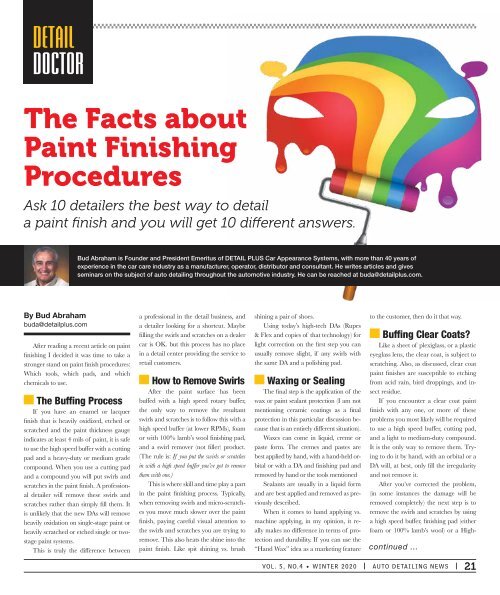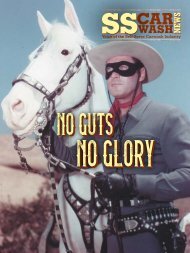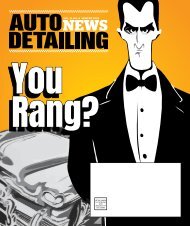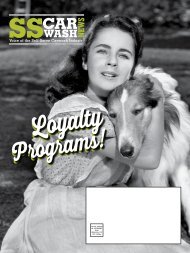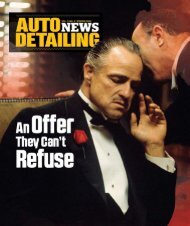Auto Detailing News Winter issue
Create successful ePaper yourself
Turn your PDF publications into a flip-book with our unique Google optimized e-Paper software.
DETAIL<br />
DOCTOR<br />
The Facts about<br />
Paint Finishing<br />
Procedures<br />
Ask 10 detailers the best way to detail<br />
a paint finish and you will get 10 different answers.<br />
Bud Abraham is Founder and President Emeritus of DETAIL PLUS Car Appearance Systems, with more than 40 years of<br />
experience in the car care industry as a manufacturer, operator, distributor and consultant. He writes articles and gives<br />
seminars on the subject of auto detailing throughout the automotive industry. He can be reached at buda@detailplus.com.<br />
By Bud Abraham<br />
buda@detailplus.com<br />
After reading a recent article on paint<br />
finishing I decided it was time to take a<br />
stronger stand on paint finish procedures:<br />
Which tools, which pads, and which<br />
chemicals to use.<br />
The Buffing Process<br />
If you have an enamel or lacquer<br />
finish that is heavily oxidized, etched or<br />
scratched and the paint thickness gauge<br />
indicates at least 4 mils of paint, it is safe<br />
to use the high speed buffer with a cutting<br />
pad and a heavy-duty or medium grade<br />
compound. When you use a cutting pad<br />
and a compound you will put swirls and<br />
scratches in the paint finish. A professional<br />
detailer will remove these swirls and<br />
scratches rather than simply fill them. It<br />
is unlikely that the new DAs will remove<br />
heavily oxidation on single-stage paint or<br />
heavily scratched or etched single or twostage<br />
paint systems.<br />
This is truly the difference between<br />
a professional in the detail business, and<br />
a detailer looking for a shortcut. Maybe<br />
filling the swirls and scratches on a dealer<br />
car is OK. but this process has no place<br />
in a detail center providing the service to<br />
retail customers.<br />
How to Remove Swirls<br />
After the paint surface has been<br />
buffed with a high speed rotary buffer,<br />
the only way to remove the resultant<br />
swirls and scratches is to follow this with a<br />
high speed buffer (at lower RPMs), foam<br />
or with 100% lamb’s wool finishing pad,<br />
and a swirl remover (not filler) product.<br />
(The rule is: If you put the swirls or scratches<br />
in with a high speed buffer you’ve got to remove<br />
them with one.)<br />
This is where skill and time play a part<br />
in the paint finishing process. Typically,<br />
when removing swirls and micro-scratches<br />
you move much slower over the paint<br />
finish, paying careful visual attention to<br />
the swirls and scratches you are trying to<br />
remove. This also heats the shine into the<br />
paint finish. Like spit shining vs. brush<br />
shining a pair of shoes.<br />
Using today’s high-tech DAs (Rupes<br />
& Flex and copies of that technology) for<br />
light correction on the first step you can<br />
usually remove slight, if any swirls with<br />
the same DA and a polishing pad.<br />
Waxing or Sealing<br />
The final step is the application of the<br />
wax or paint sealant protection (I am not<br />
mentioning ceramic coatings as a final<br />
protection in this particular discussion because<br />
that is an entirely different situation).<br />
Waxes can come in liquid, creme or<br />
paste form. The cremes and pastes are<br />
best applied by hand, with a hand-held orbital<br />
or with a DA and finishing pad and<br />
removed by hand or the tools mentioned<br />
Sealants are usually in a liquid form<br />
and are best applied and removed as previously<br />
described.<br />
When it comes to hand applying vs.<br />
machine applying, in my opinion, it really<br />
makes no difference in terms of protection<br />
and durability. If you can use the<br />
“Hand Wax” idea as a marketing feature<br />
to the customer, then do it that way.<br />
Buffing Clear Coats?<br />
Like a sheet of plexiglass, or a plastic<br />
eyeglass lens, the clear coat, is subject to<br />
scratching. Also, as discussed, clear coat<br />
paint finishes are susceptible to etching<br />
from acid rain, bird droppings, and insect<br />
residue.<br />
If you encounter a clear coat paint<br />
finish with any one, or more of these<br />
problems you most likely will be required<br />
to use a high speed buffer, cutting pad,<br />
and a light to medium-duty compound.<br />
It is the only way to remove them. Trying<br />
to do it by hand, with an orbital or a<br />
DA will, at best, only fill the irregularity<br />
and not remove it.<br />
After you’ve corrected the problem,<br />
(in some instances the damage will be<br />
removed completely) the next step is to<br />
remove the swirls and scratches by using<br />
a high speed buffer, finishing pad (either<br />
foam or 100% lamb’s wool) or a High-<br />
continued ...<br />
VOL. 5, NO.4 • WINTER 2020 | AUTO DETAILING NEWS | 21


